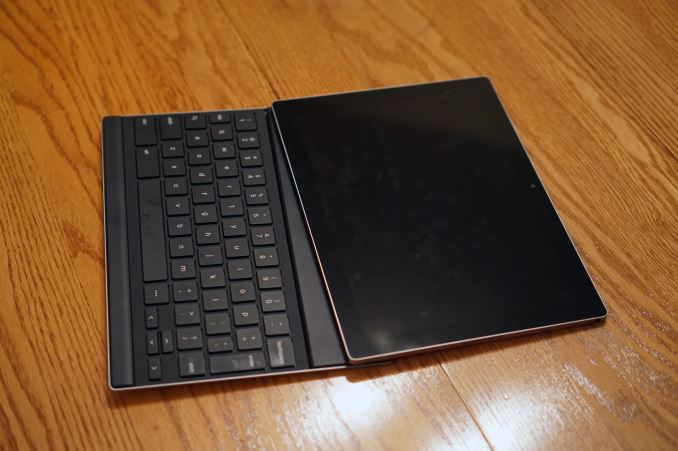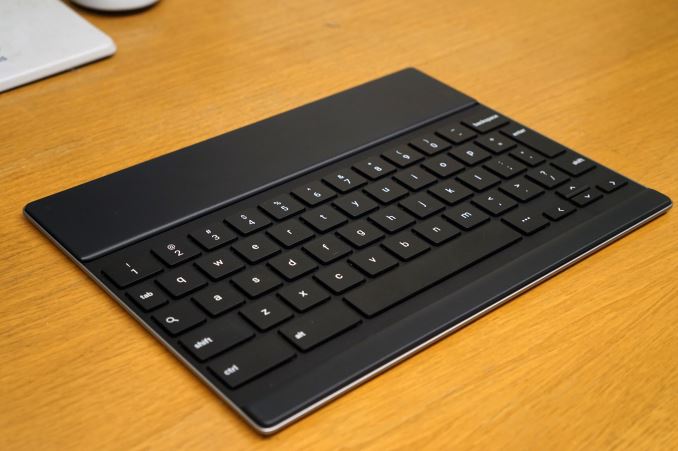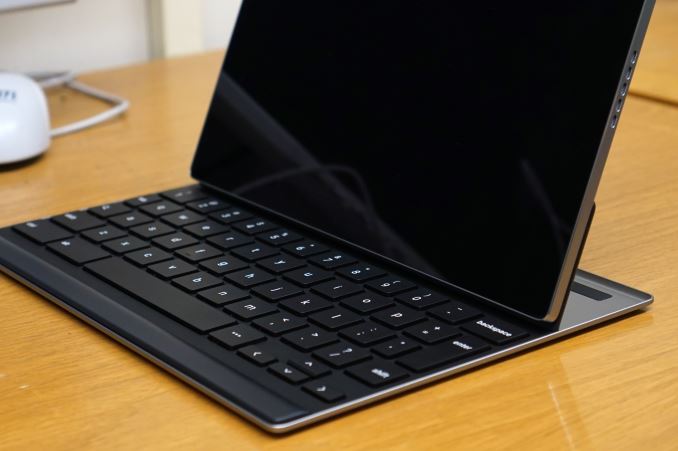The Google Pixel C Review
by Brandon Chester & Joshua Ho on January 25, 2016 8:00 AM ESTKeyboard
Part of the Pixel C’s appeal comes from the keyboard accessory. It isn’t included with the tablet itself, but this is true of most keyboards on tablets so it’s not as if the Pixel C is behind the competition in this regard. At $149 the keyboard is also well priced for one made out of machined aluminum, with full key travel and the Pixel C’s signature magnetic hinge.
Before talking about the keyboard itself, it’s probably a good idea to go over how that magnetic hinge works. The back of the Pixel C’s keyboard is a large aluminum flap with an equally large magnet on top. The best way you could describe the system is that this flap is connected to a very stiff hinge, which allows the flap to go to almost any angle up to about 85 degrees from the horizontal. The tablet has magnets embedded in its back which allow it to connect to this flap, and there’s enough strength in the connection to keep the tablet connected, as well as enough strength holding up the flap to prevent the mass of the tablet from causing it to start shifting back to a horizontal position. This system allows Google to give very fine angle adjustments without having to embed a kickstand in the Pixel C, and it’s quite a clever solution to the problem.
Of course, a unique keyboard solution does come with unique challenges. Obviously you end up with less space for the keyboard because the entire piece has to be the same size as the tablet, with a significant portion being dedicated to the magnetic flap. This is just an inherent result of the design, and while one could say it’s a waste, I would argue that the benefits of the system far outweigh this apparent downside.
The only real problem is training yourself to use the system correctly. When you put the tablet and keyboard together, you need to orient it with the tablet’s LED light bar on the same side as the keyboard’s space bar, or the keyboard won’t be able to charge using the Pixel C’s inductive charging. Unfortunately, this leads to some moments of confusion as you try to orient the tablet correctly after removing it. To split apart the keyboard and tablet Google recommends that you slide the two apart by pushing on the shorter sides of the keyboard and tablet. The first issue with this approach is that anything trapped between the keyboard and display is liable to absolutely ruin the glass, which has happened to my unit around some corners of the display.
The other issue is that once the two are separated you then need to remember to flip the tablet upward to put it in the right position to connect with the keyboard. While this seems like a natural motion, I find myself doing it incorrectly because even after sliding the two sections apart there’s still a magnetic attraction between the long edges of the tablet and keyboard, which causes me to favor rotating the tablet in order to separate them. In this case, the tablet ends up being upside down, and so you need to look at it and orient it such that the front-facing camera is on the top bezel before attaching it to the keyboard.
While some may feel that my issues working out the connection and disconnection of the keyboard are simply user error, it is worth noting that Google includes an enormous instruction sheet along with the Pixel C, and so confusion among users is clearly expected to some extent. I’ve gotten better at setting up the tablet in keyboard mode quickly, but it’s still not an action that has become a second nature to me.
Once you’ve set up the keyboard, you may notice something very familiar about it if you’ve had any experience with Google’s other Pixel products. The core part of the keyboard uses the exact same key size, pitch, and travel distance as the Chromebook Pixel. Google has shrunken the keys around the edges in order to match the keyboard to the Pixel C’s 10.2” display, but I haven’t found it to be much of a problem in use. On the contrary, I think the feel of the keyboard is great. The keys have a good tactile response, and the spacing is comfortable. In my eyes it definitely surpasses the iPad Pro’s Smart Keyboard by a large margin, although I’m not sure how well it compares to Microsoft’s Surface Type Cover.
Unfortunately, the keyboard becomes another area where the apparent mid-development switch to Android causes numerous issues. On the design side, you’ll notice that the keyboard follows the Chromebook Pixel in replacing the caps lock key with a search button. Right off the bat, I noticed a glaring issue with the implementation of this key. You can press search to open a search box anywhere, but I cannot find any way to close the search box if you open it by accident. If you open the search field you need to tap on the display to close it. There needs to be forgiveness in the design, either by making a backspace press when the field is empty close it, or by allowing you to close it by tapping search again with an empty field.
Android itself just doesn’t work very well with keyboards either. In fact, this implementation isn’t near as good as what I saw on the Dell Venue 10, and I didn’t think that provided a very good experience either. The big problem stems from the fact that Google hasn’t included proper navigation keys, which is more evidence that this device wasn’t ever meant to run Android in the first place. The omission of keys to trigger the standard home, back, and recent apps buttons is simply unacceptable. Google does have a help page online which lets you know the cryptic multiple key combos that perform these actions, but I don’t understand why a simple action like home needs to be activated by pressing search and enter, which are on entirely different sides of the keyboard. The same is true of back, which is search + backspace. Thankfully, Google does offer standard shortcuts in many of their apps, but the lack of navigational buttons on the keyboard is a big problem.
Ultimately, the Pixel C’s keyboard is a great piece of hardware, but Android doesn’t work very well with keyboards, and this keyboard in particular is ill suited to Android on top of that. Google has a very novel hinge implementation, and the inductive charging takes away the need to charge the keyboard, but many of the processes need to be streamlined and just generally made easier for the user to understand and get used to quickly. The tablet really needs to be able to attach onto and charge the keyboard without requiring a specific orientation, and the keyboard needs proper Android navigation shortcuts on top of Android simply needing much better keyboard support and applications to take advantage of one. I would love to see the ideas behind the Pixel C’s keyboard and hinge make it into keyboards from other manufacturers in the future, as well as future Android tablets that better deliver on promises of productivity abilities.














122 Comments
View All Comments
tipoo - Monday, January 25, 2016 - link
Ars theorized that this was never meant to run Android...Reading this review, it seems to add some plausibility to that.http://arstechnica.com/gadgets/2015/12/the-pixel-c...
tipoo - Monday, January 25, 2016 - link
Not that ChromeOS would really help on the app front, so Google is in a bit of a pickle.testbug00 - Tuesday, January 26, 2016 - link
ChromeOS would help a lot on the multitasking and functionality front. Think of it as a high end chromebook that has the ability to be used as a tablet.marcryan - Monday, January 25, 2016 - link
I just finished returning my Pixel C. I didn't have issues in connecting the device and keyboard nor did I have problems with Internet connectivity. But the major show stopper for me was the touch screen latency. It was insane how many times I had to touch the device to get it to respond. I even tried a stylus on the screen in a drawing program and the pixel was unable to track a straight line without breaks along the way where the screen did not register the input.Beyond that there was a supreme amount of waiting time for an app to respond after tapping on it on the home screen. I did a side by side with my Nexus 6P and the nexus (not without its own flaws) performed noticeably faster which is shocking considering the benchmark scores on the pixel C processor.
There's something fatally flawed in the device which is unfortunate because I really wanted to like it, it's a nice piece of hardware.
evefavretto - Monday, January 25, 2016 - link
Another interesting characteristic of the A-series, and by extension, Pixel C' screen is the fact that, once divided in half, the two remaining parts keep the same proportion: 1:√2.Probably a design choice for a multitasking feature that was scrapped from Chrome OS and now will see the light of the day in Android.
Dribble - Monday, January 25, 2016 - link
Thank you for the NAND performance charts - I have been bitten twice by cheap and nasty NAND killing my tablet's performance after a year or two. I now won't touch one unless I know it's NAND is decent - and pixel C really is pretty borderline considering how high end it's meant to be.Agree google has software problems, although I would say it goes beyond missing features. It's clearly far to hard to keep something working as you upgrade. Almost every device I have owned has worked best on whatever version of android it came with. Every upgrade generally introduces problems. I get the feeling they developed the pixel c with android 5 and I bet it worked fine there, then they did an upgrade too 6 and now have all manor of niggles to sort out. Hence I am actually more drawn to devices that don't have major android version upgrades. I'll take an out of date but working version of android over the latest and greatest but slightly broken every time.
Dobson123 - Monday, January 25, 2016 - link
There is a mistake in the chart on the first page: The Tegra K1 has 192 shader units, not 128.And do you know why they have disabled the A53 cores?
Kepe - Monday, January 25, 2016 - link
Judging by the overall unfinishedness of the Pixel C, I'd guess migrating from the small cores to the big ones and vice versa causes some kind of a performance issue Google couldn't solve, as the Tegra X1 doesn't have heterogenous multi-processing.. So there'd be even more lag and performance issues than there is now.But perhaps it doesn't really even matter, since the big cores go as low as 51 MHz. It probably wouldn't save much power (if at all) if the little cores were used when there's a low workload. Battery performance seems to be really good even without the little cores.
Brandon Chester - Monday, January 25, 2016 - link
Indeed you are right. I've corrected the error.As for the cluster migration, just keep in mind that the SHIELD TV doesn't do it either. Granted, that is plugged into the wall so power isn't a big deal, but it's important to note that we haven't see a single implementation where the A53s are used so I wouldn't be quick to blame it on the Pixel C specifically.
tipoo - Monday, January 25, 2016 - link
For the SHIELD does it not do switching, or does it turn the A53s off completely? As something plugged into a wall and with overkill cooling for an ARM SoC, it may as well use all 8 all the time, no?